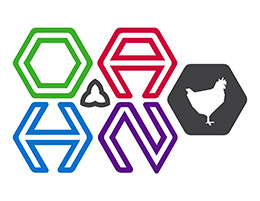Ontario Animal Health Network (OAHN)
Poultry Expert Network
Quarterly Veterinarian Report
Poultry Veterinarian Survey Highlights – Q4 2024 (Sep -Dec 2024)
Broilers
Overall, this quarter, most of the conditions were described as stable except late bacterial infections associated with E. coli and E.cecorum.
Also, when looking back at disease trends relating to Runting Stunting Syndrome (RSS) cases, the highest number of cases (confirmed and suspicious) occur in Q1 and Q2 (December 1 to May 31) with fewer cases in Q3 and Q4 (June 1 to Nov 30). RSS cases (confirmed and suspicious) dropped from Q1/Q2 of 2021 to Q1/Q2 of 2022 but have remained consistent since then.
Practitioners
Stable conditions: Early systemic bacterial infection (< 14 days old), Salmonella, chicken anemia virus infections (CAV), lameness developmental and nutritional, coccidiosis, ascites, histomoniasis, spiking mortality, avian metapneumovirus infection (aMPV), infectious laryngotracheitis (ILT) and avian influenza (AI). Condemnation issues were related mainly to chronic respiratory disease (CRD), cellulitis and hepatitis.
Stable to increased conditions: Late systemic bacterial infection (>14 days old), infectious bronchitis (IBV), necrotic enteritis, lameness of bacterial origin and lameness of viral origin caused by multiple reovirus variants (BC, China, SK and ON) detected on gene sequencing.
Stable to decreased conditions: Infectious bursal disease (IBDV).
Equally stable, increased, or decreased conditions: Inclusion body hepatitis (IBH).
One case of mycotic airsacullitis was diagnosed in a broiler flock this quarter.
Percentage of E. coli resistant to TMS this quarter was between 5 and 50 %.
Frequency of conditions seen in the flocks:
Common to very common: Late systemic bacterial infection.
Common: Early systemic bacterial infection, lameness of bacterial origin and condemnation issues.
Common or rare: Ascites, IBH, IBV and lameness of viral origin and condemnations.
Common, rare or not seen: Necrotic enteritis, coccidiosis, lameness viral and IBDV.
Rare to not seen: Salmonellosis, lameness developmental and nutritional, spiking mortality, histomoniasis, RSS and aMPV.
Not seen: ILT, CAV and AI.
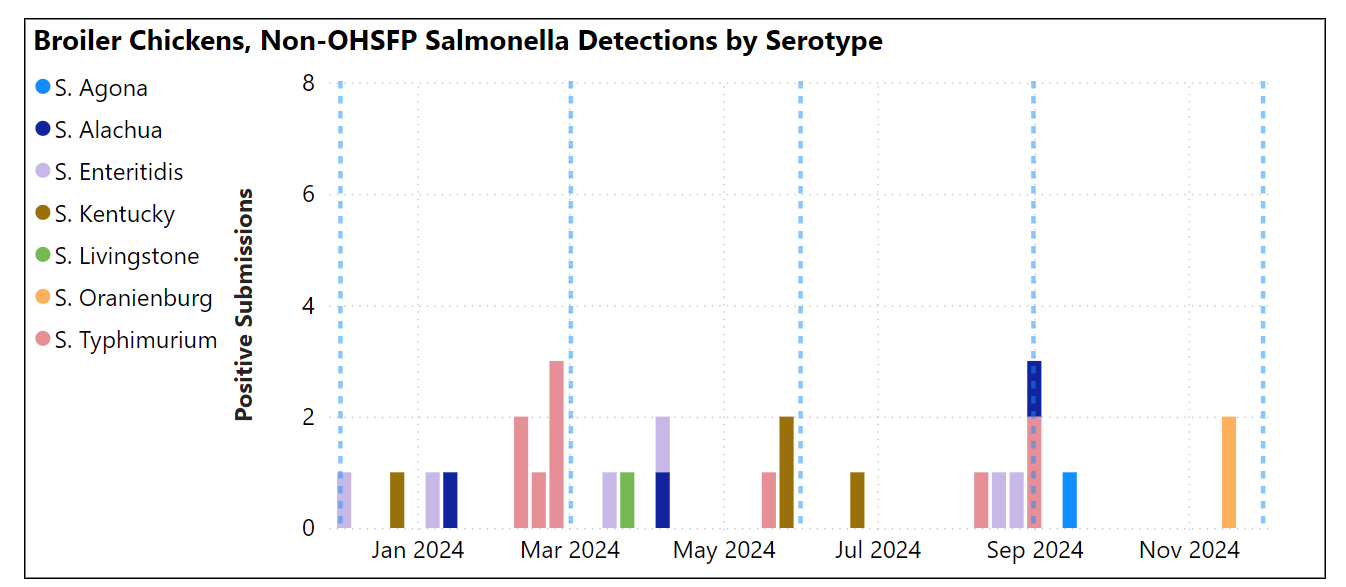
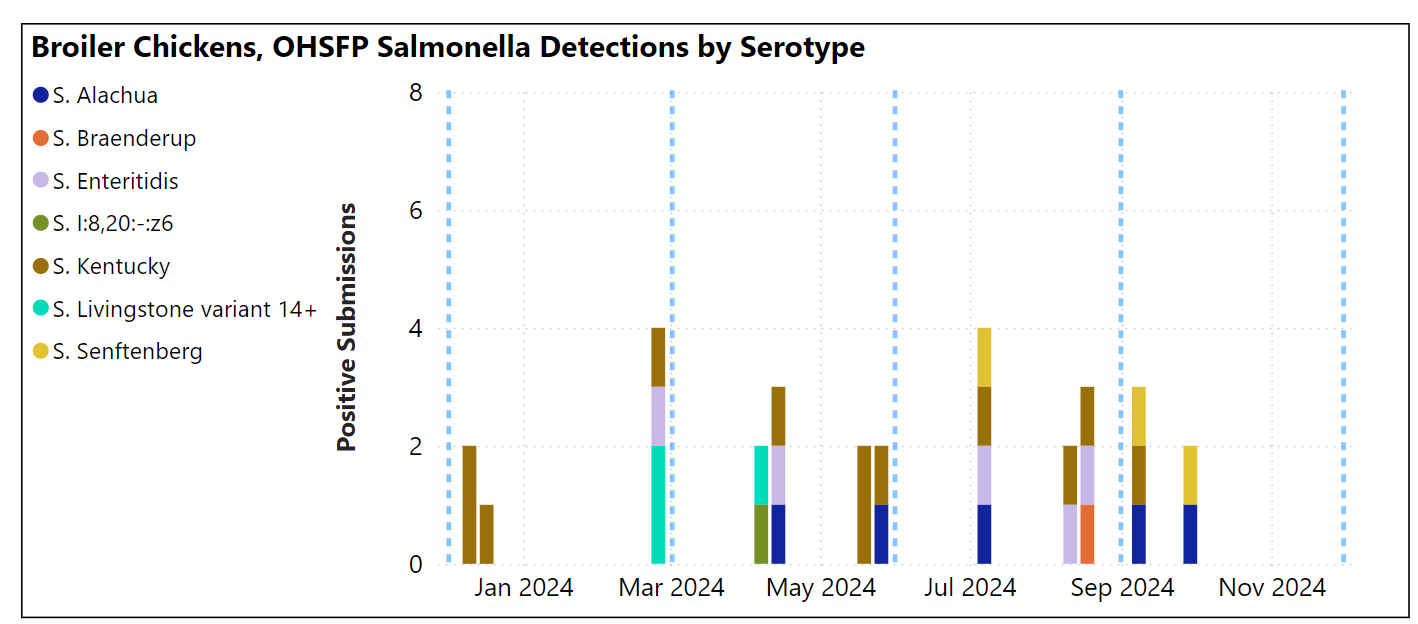
Condemnation conditions in provincial slaughter plants:
The top carcass postmortem condemnation conditions reported for September-November 2024 were contamination, ascites, and cellulitis.
Comparison of provincial condemnation conditions:
January-November 2023 (top) vs. January-November 2024 (bottom)
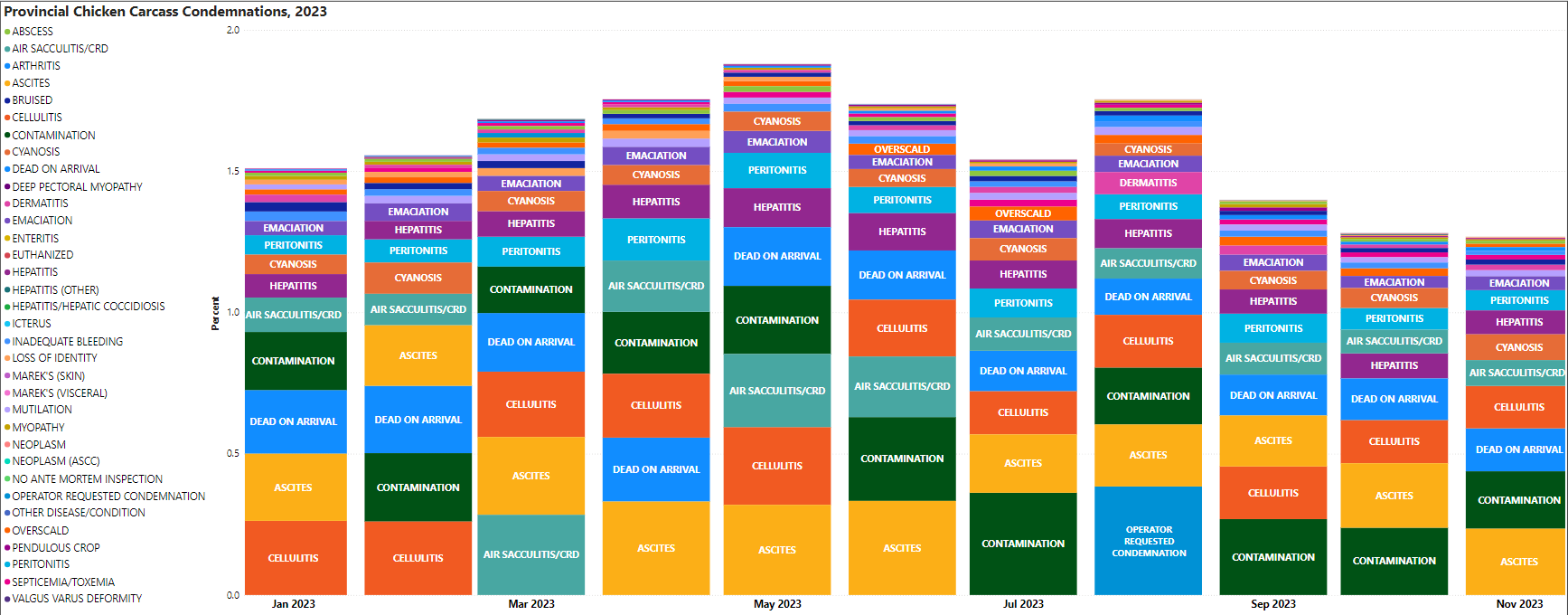
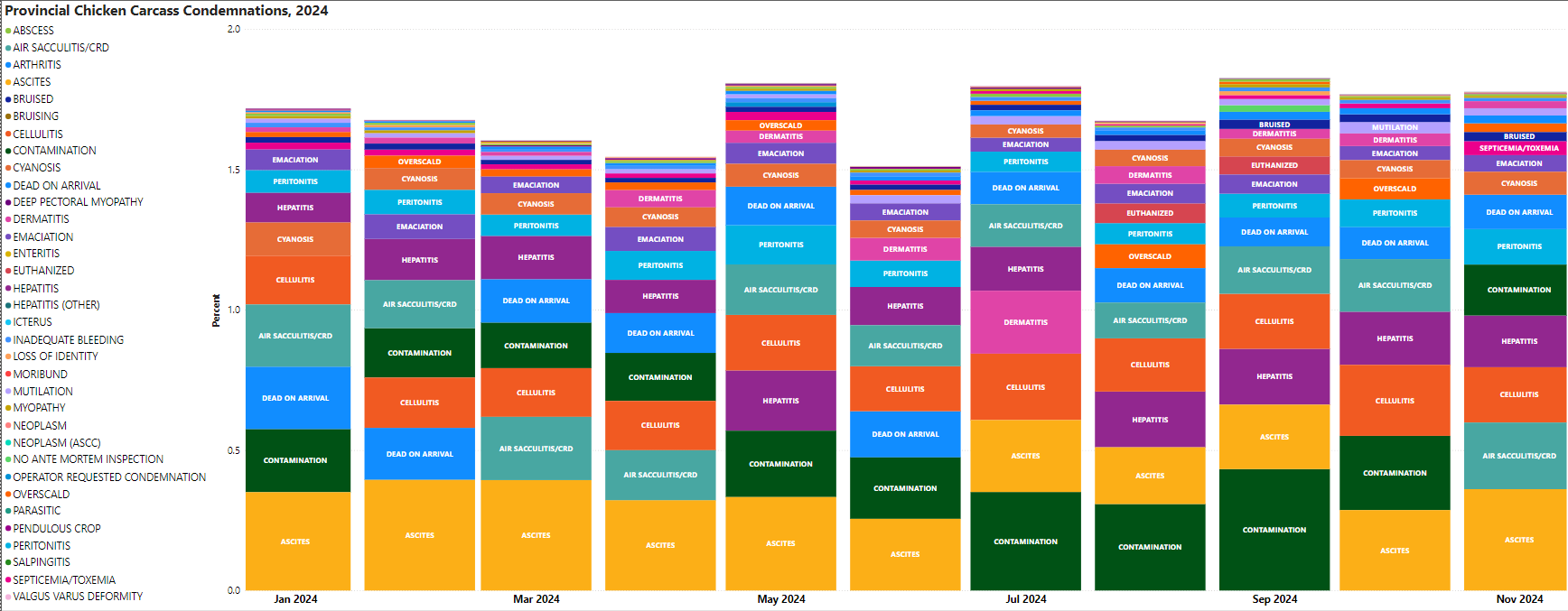

Number of chickens slaughtered by province, Jan-Dec 2024. From CAHSS Federally Inspected Slaughter Data.

Top 10 chicken postmortem condemnation conditions per 10,000 slaughtered by province, Jan-Nov 2024, from CAHSS Federally Inspected Slaughter Data. Subcutaneous conditions, abdominal edema, and respiratory conditions were reported as the main conditions for condemnation for chickens slaughtered in federally inspected plants in Ontario (dark green bars).
Broiler-Breeders
Overall, this quarter, the health status of the flocks was stable except increased cases of bacterial lameness mostly occurring at 4-6 weeks old leading to multiple rounds of treatments. The main bacteria isolated were S. aureus, E. cecorum and E. coli.
Practitioners
Stable conditions: Other causes of mortality, viral/nutritional and developmental lameness, necrotic enteritis, coccidiosis, fowl pox, ILT, Salmonellosis, Mycoplasma, disease related hatchability issues, aggression and cannibalism, pre-lay morbidity/mortality (<20 weeks) and aMPV.
Stable to increased conditions: Early bacterial infection, histomoniasis and bacterial lameness related to S. aureus, E. coli and E. cecorum.
Stable to decreased conditions: Fowl cholera, CAV, in-lay bacterial septicemia, IBV decreased production/abnormal egg and IBV sudden spike in mortality.
Comments: One case of gout, gangrenous dermatitis, one detection of IBV serotype G08 and increasing numbers of Salmonella Kentucky detection with the environmental sample testing.
Frequency seen in the flocks:
Very common to common: Bacterial lameness.
Common to rare: In-lay bacterial septicemia and bacterial lameness.
Common, rare or not seen: Other causes of early mortality, coccidiosis and pre-lay morbidity/mortality.
Rare or not seen: Fowl cholera, lameness developmental/nutritional, IBV decreased prod/abnormal egg, IBV sudden spike in mortality, necrotic enteritis, mycoplasmosis, disease related hatchability issue, aggression and cannibalism, multi-drug-resistant E. coli, histomoniasis and aMPV.
Not seen: CAV, lameness viral origin, fowl pox, ILT, clinical salmonellosis and AI.
AHL
Fowl cholera (Pasteurella multocida) – Occasionally isolated from lameness cases from vaccinated flocks.
Similar number of cases (from previous quarter):
Necrotic enteritis.
Intestinal parasitism – Histomonas, Ascaridia, and Heterakis.
Increased number of cases (from previous quarter):
Early bacterial infection (<14 days old) – Cases had E. coli isolated in pure culture or in combination with E. cecorum or E. cecorum and P. aeruginosa.
Other causes of mortality (> 14 days old) – Dehydration and intussusception.
Cellulitis/Dermatitis – E. coli and S. aureus together as well as with E. cecorum. Additional related diagnoses included necrotic dermatitis, mycotic dermatitis and granulomatous cellulitis/myositis.
Bacterial pneumonia – S. aureus and E. cecorum together as well as with E. coli. Also S. aureus with G. anatis.
Trauma (Fracture, quadriceps muscle hemorrhage and necrosis).
Pododermatitis (Avibacterium spp.).
Lameness viral – Reovirus (1 case histology, PCR).
IBV (decreased productivity/abnormal eggs/sudden spike in mortality) – (IBV_USA_GA98 field strain, IBV_DMV_ON_21-017385, IBV_USA_DMV-1639-11, IBV_Mass-MA5 vaccine, and IBV_Conn vaccine).
White Chick Syndrome.
Decreased number of cases (from previous quarter):
Prelay morbidity/mortality (<20 weeks) – S. aureus was isolated in pure culture or in combination with E. coli, E. coli and E. cecorum, or E. cecorum and G. anatis. The remaining cases had E. coli isolated with E. cecorum or pure culture of C. septicum.
Other prelay diagnoses included intussusception. Also, testing for CAV revealed multiple strains including CAV_ON_18-066603-0001 and CAV_TW_2012-1207PT05 field strain. Testing for IBDV identified IBDV-USA OH-Sel1-2012 field strain.
Inlay bacterial septicemia – In all cases E. coli is isolated in pure culture or with S. aureus, E. cecorum, or C. perfringens. Other combinations include E. coli and S. aureus together with either E. cecorum or G. anatis.
Avian metapneumovirus (Type B. Concurrent infections: Septicemia).
Lameness developmental (tibial dyschondroplasia).
Lameness bacterial – S. aureus, E. coli, and E. cecorum were each isolated in pure culture or in various combinations (S. aureus isolated with E. coli or E. coli and E. cecorum). S. aureus also isolated with P. multiocida. Avibacterium spp. also isolated in pure culture. A case of osteomyelitis had E. coli and S. aureus isolated. There was also 1 case of vertebral osteomyelitis (E. cecorum).
Coccidiosis – Identified in the small intestines and ceca.
Other causes of inlay mortality – Cannibalism, heat stress and heart failure.
No cases diagnosed this quarter:
Lameness nutritional (rickets).
Fowl pox.
ILT and Mycoplasmosis.
Other diagnostic findings:
Gangrenous dermatitis (C. septicum / E. cecorum / E. coli, S. aureus / E. coli, S. aureus / E. coli / C. perfringens, E. coli / E. cecorum / S. aureus), subcutaneous abscesses (C. perfringens / E. coli / S. aureus), neoplasia (lymphoid, carcinoma), otitis interna (S. aureus), salpingitis (E. coli), sinusitis (mycotic), conjunctivits/blepharitis, pulmonary mineralization, chronic hepatitis, fatty liver, enterotyphlitis, epididymitis, yolk peritonitis, urate nephrosis/visceral urates and amyloidosis (including articular).
Salmonellosis (clinical)/Salmonella isolation
Animal Health Laboratory Salmonella Isolations in Broiler Breeders (see graph below, blue dashed lines indicate quarter periods Dec-Feb, Mar-May, Jun-Aug, Sept-Nov):
2 positive submissions outside of OHSFP testing (Ontario Hatchery and Supply Flock Program) with S. Typhimurium and S. Worthington isolated (not shown).
OHSFP environmental samples – S. Kentucky and S. Enteritidis most isolated (top right graph showing Sept-Nov 2024 isolations only).
Three OHSFP excess mortality submissions with 3 serotypes detected (below, bottom right graph).
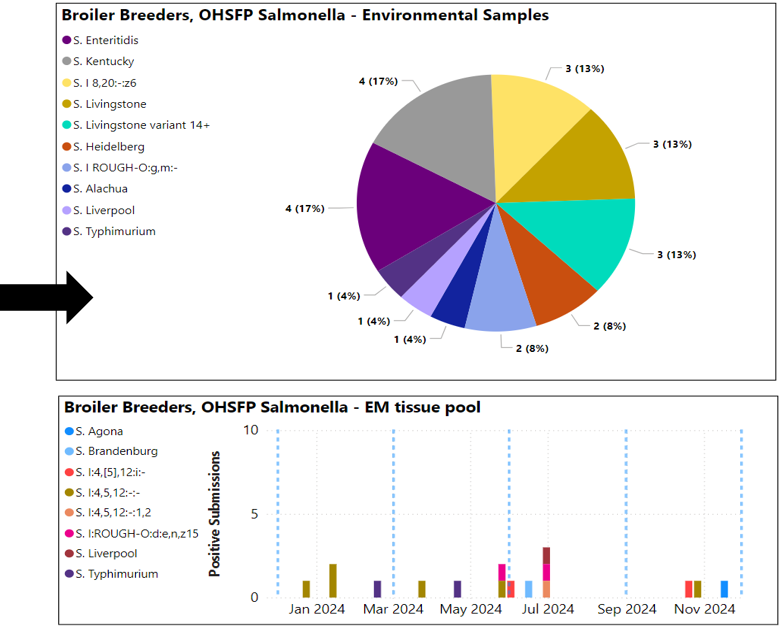
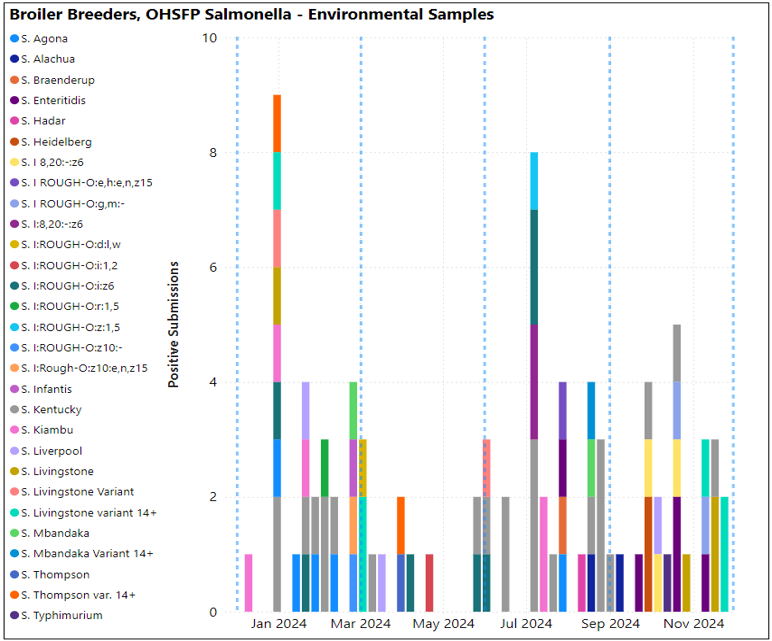
Layers
Practitioners
Veterinarians are reporting good, stable and solid health status. However, there are layer flocks experiencing slow onset of production that reaches up to 93%, will stall for approximately 4-6 weeks, then will slowly reach peak production. Affected flocks are at normal mortality and culling rate, do not present any clinical signs, and do not have decreased feed or water consumption during this period. This condition was attributed to aMPV infection as in most cases the aMPV ELISA tests were positive.
Stable conditions:
Osteoporosis, bacterial peritonitis/salpingitis, early systemic bacterial infection, other causes of early mortality, focal duodenal necrosis (FDN), ILT, mycoplasmosis , hysteria, salmonellosis, coccidiosis, necrotic enteritis, aggression, cannibalism, histomoniasis and multi-drug-resistant E. coli.
Stable to decreased: IBV (production drop/abnormal eggs/ respiratory).
Other comments: Young layer flock experiencing peripheral neuropathy like syndrome that resembles Marek’s disease. It was postulated that symptoms may represent an autoimmune reaction to nerve tissue because of response to a combination of common vaccines in certain layer breeds (Characterization and experimental reproduction of peripheral neuropathy in White Leghorn chickens – PubMed). Same flock also had IBDV issues.
Frequency of detection in the flocks:
Common, rare, or not seen: Osteoporosis, aggression, cannibalism, bacterial peritonitis, aMPV and focal duodenal necrosis (FDN).
Rare to common: Bacterial salpingitis/peritonitis (E. coli).
Rare or not seen: Early systemic bacterial infection, other causes of early bacterial infection, ILT, hysteria, histomoniasis, mycoplasmosis, coccidiosis, IBV (production drop/egg abnormalities/ respiratory), necrotic enteritis and multi-drug-resistant E. coli.
Not seen: Clinical salmonellosis, ILT and AI.
AHL
Similar number of cases (from previous quarter):
Early mortality (<14 days old, omphalitis).
In-lay mortality (>20 weeks old) – E. coli and aMPV (increased ELISA titres).
Focal duodenal necrosis (FDN).
Coccidiosis (ceca).
Increased number of cases (from previous quarter):
Early mortality (<14 days old, starveouts).
Prelay mortality (<20 weeks old) – Septicemia, E. coli, sinusitis and IBDV (1 – 66-Indiana-2014).
Leg issues (other) – Tendonitis/cellulitis and skeletal muscle necrosis/ myositis/ hemorrhage.
Necrotic enteritis.
Elevated DOA – IBV suspicious histology.
Decreased number of cases (from previous quarter):
Early mortality (other).
Infectious bronchitis (IBV – production drop/egg abnormalities/ respiratory) – (IBV_CA_1734_04_ON_12-025379 and IBV_Mass-MA5 vaccine).
Avian metapneumovirus.
No cases diagnosed this quarter:
Osteoporosis.
Leg issues – Trauma, bone fracture.
Leg issues – Bacterial.
Intestinal parasitism (other).
Aggression/Hysteria.
ILT.
Mycoplasma.
Other diagnostic findings:
Sinusitis and peripheral neuritis.
Salmonellosis (clinical) / Salmonella isolation
Animal Health Laboratory Salmonella Isolations (graphs below, blue dashed lines indicate quarter periods Dec-Feb, Mar-May, Jun-Aug, Sept-Nov):
Layers: No positive submissions outside of OHSFP, no non-environmental OHSFP samples positive (below, left).
Layer breeders: No positive samples outside of OHSFP, no non-environmental OHSFP samples positive (below, right).
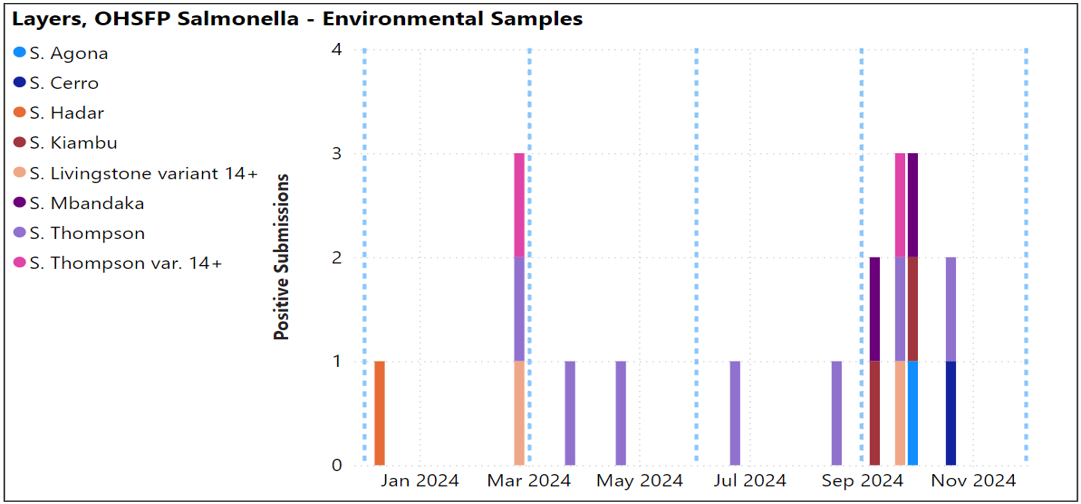
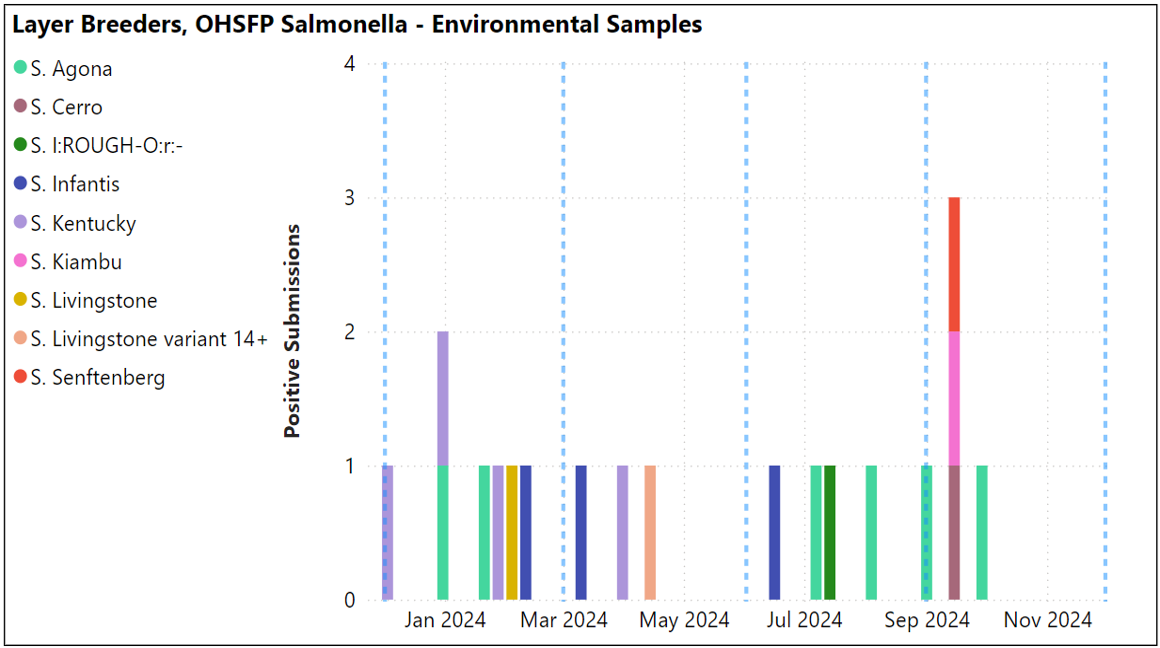
Turkeys
Practitioners
Turkey flocks continue to have health challenges with aMPV type B infection listed as main condition this quarter. Flocks have increased mortality, and many have secondary E. coli infections. Otherwise, practitioners are reporting flocks with good health status and with great performance.
Stable conditions: Fowl cholera, erysipelas, other causes of early mortality (starve out and dehydration), necrotic enteritis, enteritis, mycoplasmosis (M. gallisepticum), round heart, Salmonella isolation, aggression and cannibalism.
Stable to increased: Early systemic bacterial infection (E. coli and Streptococcus gallolyticus), ORT, late systemic bacterial infection (E. coli), coccidiosis, histomoniasis, aMPV, other respiratory and mycotic respiratory disease and multi-drug-resistant E. coli.
Stable to decreased: Reovirus tenosynovitis.
Frequency of conditions in the flocks:
Common, rare or not seen: aMPV, aggression and cannibalism, coccidiosis, enteritis,
early systemic bacterial, and late systemic bacterial infection.
Rare or not seen: Other causes of early mortality, ORT, erysipelas, mycotic respiratory disease, histomoniasis, necrotic enteritis, round heart, multi-drug-resistant E. coli, Salmonella clinical, and reovirus tenosynovitis.
Not seen: Fowl cholera.
AHL
Similar number of cases (from previous quarter):
None.
Increased number of cases (from previous quarter):
Early systemic bacterial infection (<14 days old) – E. coli, airsacculitis and aMPV.
Avian metapneumovirus – Type B
Mycotic respiratory disease – Pneumonia.
Enteric disease – Intestinal cryptosporidiosis.
Coccidiosis/Parasitism – Coccidiosis small intestine and ceca.
Necrotic enteritis.
Histomoniasis.
Reovirus – PA 01769-14.
Decreased number of cases (from previous quarter):
Late systemic bacterial infection (>14 d old) – E. coli isolated in pure culture.
Bacterial pneumonia.
Tibial dyschondroplasia.
No cases diagnosed this quarter:
Fowl cholera (Pasteurella multocida).
Erysipelas.
Other causes of early mortality (<14 days old).
ORT (Ornithobacterium rhinotracheale).
Mycoplasma.
Rickets.
Condemnations.
DOA.
Other diagnostic findings:
HEV inclusions (spleen), tenosynovitis, arthritis (E. coli), dermatitis, tibial rotation, osteomyelitis (1 cranial, 1 vertebral), chondrodystrophy, conjunctivitis, myopathy/ myodegeneration, dehydration and ingluvitis (Candida albicans).
Salmonellosis (clinical)/Salmonella isolation:
Practitioners: Reported stable to slightly increased. S. Hadar, S. Newport, S. Albany and S. Montevideo were listed as the main isolates.
Animal Health Laboratory Salmonella Isolations: Turkey – Meat
OHSFP – No detections.
Non-OHSFP: S. Heidelberg most isolated (see below, blue dashed lines indicate quarter periods Dec-Feb, Mar-May, Jun-Aug, Sept-Nov).
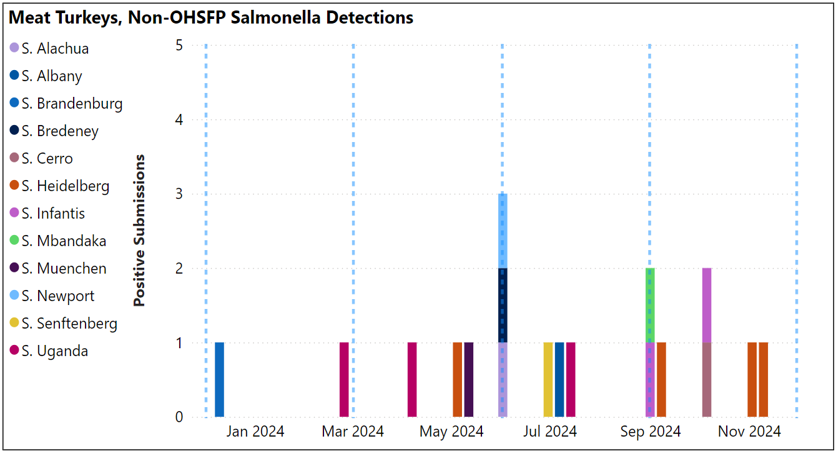
Animal Health Laboratory Salmonella Isolations: Turkey – breeders
OHSFP – All environmental samples this quarter, S. Hadar most isolated (see below, blue dashed lines indicate quarter periods Dec-Feb, Mar-May, Jun-Aug, Sept-Nov).
Non-OHSFP – 4 positive submissions, S. Hadar, S. Uganda, S. Newport, S. Typhimurium and S. Ouakam isolated (not shown).
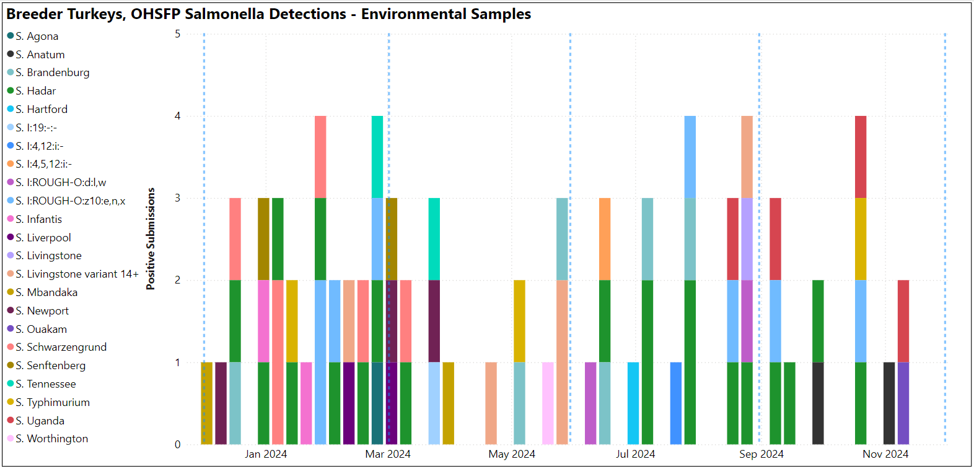
Provincial slaughter plants condemnations:
The top carcass postmortem conditions reported for September to November 2024 were airsacculitis, abscess, contamination, and hepatitis.
Comparison of provincial condemnation conditions:
January-November 2023 (top) vs. January-November 2024 (bottom)
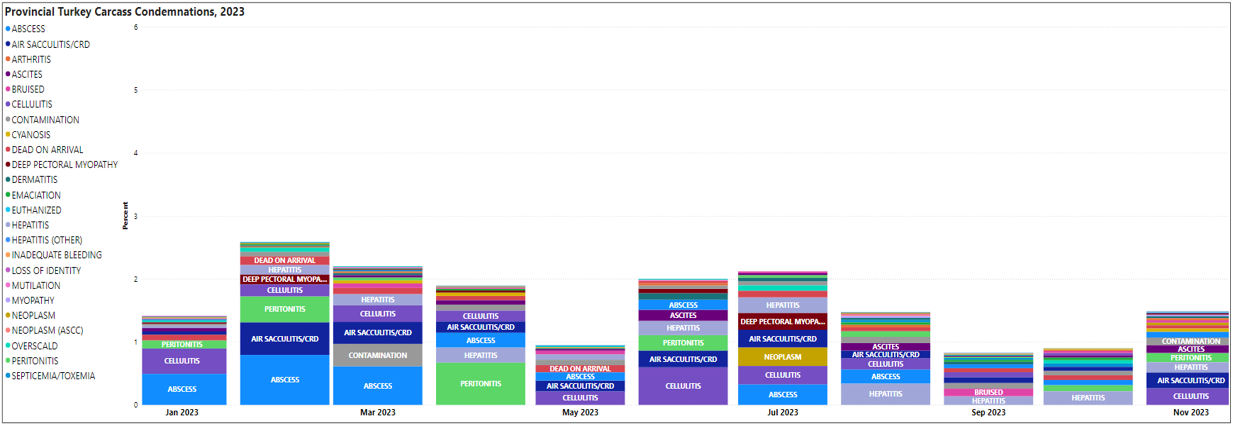
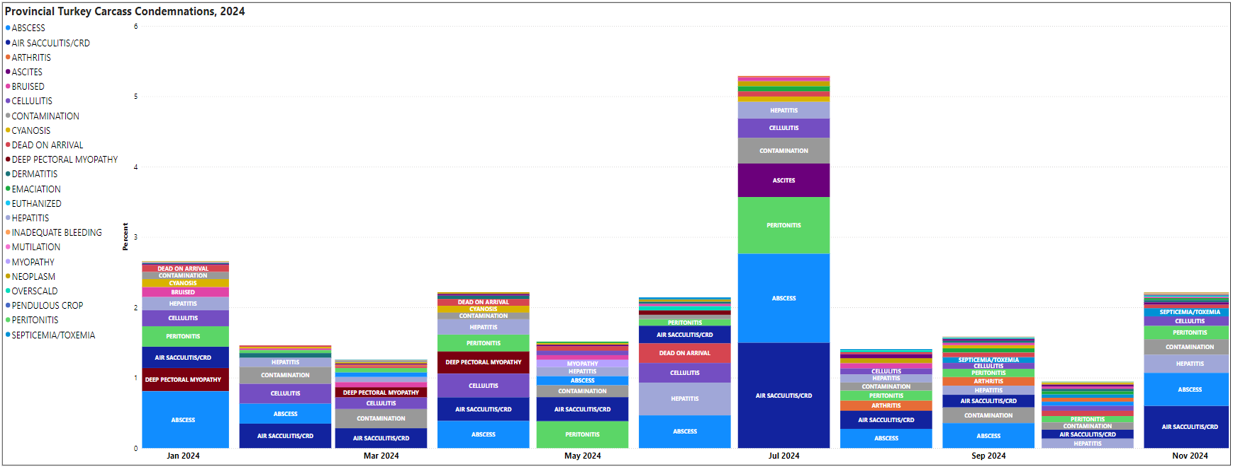

Number of turkeys slaughtered by region, Jan-Dec 2024. From CAHSS Federally Inspected Slaughter Data.

Top 10 turkey post mortem condemnation conditions per 10,000 slaughtered, Jan-Nov 2024, from CAHSS Federally Inspected Slaughter Data. Subcutaneous conditions, emaciation, and “other” conditions were reported as the main conditions for condemnation for turkeys slaughtered in federally inspected plants in Ontario.
Small Flock
Chickens:
AHL: Diagnoses at AHL included lice, mites (NFM, Knemidocoptes), intestinal parasitism (coccidiosis, heterakis, nematodes (Ascaridia, Capillaria), cestodes), Marek’s disease, neoplasia (lymphoid neoplasia, oral epithelial neoplasia, myelocytomatosis, SCC), bacterial septicemia, pneumonia (granulomatous), M. gallisepticum / M. synoviae, stomatitis, conjunctivitis, sinusitis, IBV (suspicious histologic lesions), emaciation, fatty liver and Macrorhabdos ornithogaster.
ILT: 3 cases (1 CEO/TCO vaccine-like strain TCAA cluster and 2 too weak to type).
Gamebird/Ratities:
AHL: One quail case submitted this quarter.
Quail: Marek’s disease.
Waterfowl:
AHL: Three duck cases submitted this quarter.
Ducks:
1) Pekin: Septicemia (S. gallolyticus, E coli).
2) Duck: Conjunctivitis, blepharitis, bacterial pneumonia (S. gallolyticus, E. coli, C. perfringens, E. cecorum).
3) Muscovy: Visceral urate deposits.
Pigeons:
AHL: Two pigeon cases submitted this quarter.
1) Mycotic airsacculitis and pneumonia (Aspergillus spp.) as well as septicemia (E. coli, P. multocida).
2) Stomatitis and emaciation.
Practitioners: No information provided with the clinical impression on any of the small flock species for this quarter.
Poultry research from Ontario and beyond
- DNA Immunization as a Safe and Economical Vaccination Strategy Against Infectious Laryngotracheitis Virus (ILTV) to Enhance Mucosal Protection in Primary Sites of Infection turkey rhinotracheitis | CABI Compendium
- Characterization and experimental reproduction of peripheral neuropathy in White Leghorn chickens – PubMed
- Full article: Use of real-time PCR to rule out Marek’s disease in the diagnosis of peripheral neuropathy
Events and News
Poultry Industry Council events: https://www.poultryindustrycouncil.ca/events
Poultry Health Research Network information, events, and lectures can be accessed on the PHRN website: https://phrn.net/ or on the PHRN YouTube channel: https://www.youtube.com/user/PoultryHRN
Thank You!
We thank the following poultry veterinarians who completed the veterinary survey:
Dr. Tim Abolarin, Dr. Elizabeth Black, Dr. Joanne Dias, Dr. Daniella Di Pirro, Dr. Shahbaz Haq, Dr. Elana Huong, Dr. Anastasia Novy, Dr. Mike Petrik, Dr. Ben Schlegel, Dr. Chanelle Taylor, Dr. Brenna Tuer, Dr. Alex Weisz, and Dr. Jessalyn Walkey.
